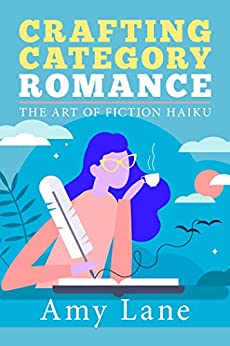 Crafting Category Romance: The Art of Fiction Haiku
Crafting Category Romance: The Art of Fiction Haiku Romance Fiction Writing Reference
DSP Creatives
September 8, 2020
202

Category romance is a precise art. With such a small word count, writing the perfect category romance is a little like writing a haiku. But how do you write a book in seventeen syllables? How can you cram compelling conflict, satisfying character development, and toe-curling romantic tension into less than sixty thousand words?
In Crafting Category Romance, two-time RITA™-nominated author of nearly one hundred books Amy Lane describes the rules of engagement, traps to watch out for, and how to leverage common tropes to create conflict, craft a character, develop a plot, and leave readers with a happy ever after that's different every time—all in a tidy package. With practical exercises in plot, conflict, and character development, Crafting Category Romance will teach you how to use the rigid rules and expectations of the genre to your advantage and win a loyal readership following for life.

Reviewed by Charlayne Elizabeth Denney
Member of the Paranormal Romance Review Team
We’ve all read them, picked up at a grocer’s checkout in the past. Or, like my sister, had a subscription; a box of them would be delivered once a month and I would see her disappear in the bedroom to read. Category romances were those popcorn romance books that you could read between cooking, bathing kids, and at bedtime.
They were predictable. What’s the old trope? Boy meets girl, girl ignores boy, boy finds a way to get her attention, they talk, they fight, they make up, have sex….the end. You would have one that was set in Scotland with a kilt-clad hottie or in England’s Regency era with rich people courting. Modern men chasing the secretary or the rich woman pursuing the pool boy, these were all part of that short romance fiction published by companies like Harlequin.
It would be easy to write one, right. Simple formula with a few pages of sex (or hints of it), short word count, 40-60,000 words.
It’s not only harder than it looks but the genre has evolved. Now there are so many ways to combine those words and change up the story while still staying within the parameters of the formula.
This is where Amy Lane takes you. She’s used the haiku formula of five-seven-five syllables to explain how to write short, power-packed romance novels. She addresses tropes and the rules for them, and how to break the rules and when. She talks you through how those rules are put together, why they are the way they are.
She discusses how to find out what the publisher is looking for and how to make your book fit those requirements. She discusses the various sexual requirements, different heat models, from “clean” sex to the no-holds-barred sex with the lights on are explained and what goes in each category.
It’s a lot to read through. I had a notebook next to me to keep notes because Amy has so much good information in this power-packed book. I found that, even if you’re not writing category romance, the information she has in the book is very useful for other fiction categories.
And the best part, she has exercises for you to work through for practice to get your creative brain working. This actually slowed my reading down because I got into writing the exercises and learning.
This isn’t a deep dive tome where you can get bored, Amy’s very readable style kept me interested through the whole book. I learned a lot from this one and I am excited to try out some of the techniques.
If you want to write romance, or any fiction, this should be in your library.

Reviewed by Sherry Perkins
Member of the Paranormal Romance Guild Review Team
Write a romance? What! I can do that? Really? Well, read Amy Lane’s book, “Crafting Category Romance: The Art of Fiction Haiku,” and find out. Because it seems writing romance is easier than you might imagine.
First, I liked the concept. Romances (and other genres as well) obviously have basic formulae. Of course, talent is crucial, but Lane offers a step-by-step process to get you started on the road to success in romance writing, kind of that “fake it till you make it” idea.
Second, it was a clever and engaging format with plenty of examples and opportunity for practice. Likening writing romance to writing haiku was, I thought, a wonderful analogy.
And finally, the advice comes from an author with over one hundred category romances to her name. She is good at what she does and is happy to share what she knows. I’d take advantage of it, if I were you.
